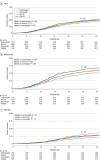Early Sepsis-Associated Acute Kidney Injury and Obesity
- PMID: 38319660
- PMCID: PMC10848068
- DOI: 10.1001/jamanetworkopen.2023.54923
Early Sepsis-Associated Acute Kidney Injury and Obesity
Abstract
Importance: The prevalence of obesity is increasing in the intensive care unit (ICU). Although obesity is a known risk factor for chronic kidney disease, its association with early sepsis-associated acute kidney injury (SA-AKI) and their combined association with patient outcomes warrant further investigation.
Objective: To explore the association between obesity, early SA-AKI incidence, and clinical outcomes in patients with sepsis.
Design, setting, and participants: This nationwide, prospective cohort study analyzed patients aged 19 years or older who had sepsis and were admitted to 20 tertiary hospital ICUs in Korea between September 1, 2019, and December 31, 2021. Patients with preexisting stage 3A to 5 chronic kidney disease and those with missing body mass index (BMI) values were excluded.
Exposures: Sepsis and hospitalization in the ICU.
Main outcomes and measures: The primary outcome was SA-AKI incidence within 48 hours of ICU admission, and secondary outcomes were mortality and clinical recovery (survival to discharge within 30 days). Patients were categorized by BMI (calculated as weight in kilograms divided by height in meters squared), and data were analyzed by logistic regression adjusted for key characteristics and clinical factors. Multivariable fractional polynomial regression models and restricted cubic spline models were used to analyze the clinical outcomes with BMI as a continuous variable.
Results: Of the 4041 patients (median age, 73 years [IQR, 63-81 years]; 2349 [58.1%] male) included in the study, 1367 (33.8%) developed early SA-AKI. Obesity was associated with a higher incidence of SA-AKI compared with normal weight (adjusted odds ratio [AOR], 1.40; 95% CI, 1.15-1.70), as was every increase in BMI of 10 (OR, 1.75; 95% CI, 1.47-2.08). While obesity was associated with lower in-hospital mortality in patients without SA-AKI compared with their counterparts without obesity (ie, underweight, normal weight, overweight) (AOR, 0.72; 95% CI, 0.54-0.94), no difference in mortality was observed in those with SA-AKI (AOR, 0.85; 95% CI, 0.65-1.12). Although patients with obesity without SA-AKI had a greater likelihood of clinical recovery than their counterparts without obesity, clinical recovery was less likely among those with both obesity and SA-AKI.
Conclusions and relevance: In this cohort study of patients with sepsis, obesity was associated with a higher risk of early SA-AKI and the presence of SA-AKI modified the association of obesity with clinical outcomes.
Conflict of interest statement
Figures



References
Publication types
MeSH terms
LinkOut - more resources
Full Text Sources
Medical

